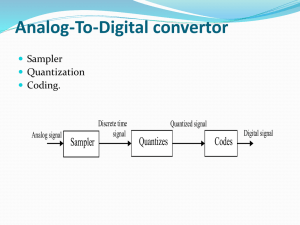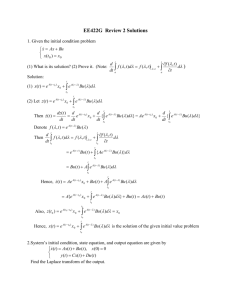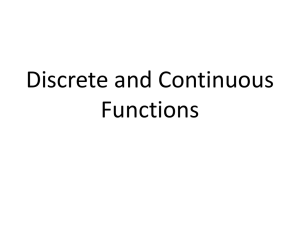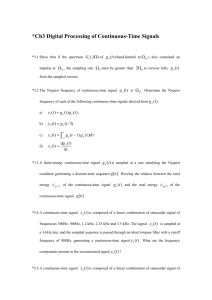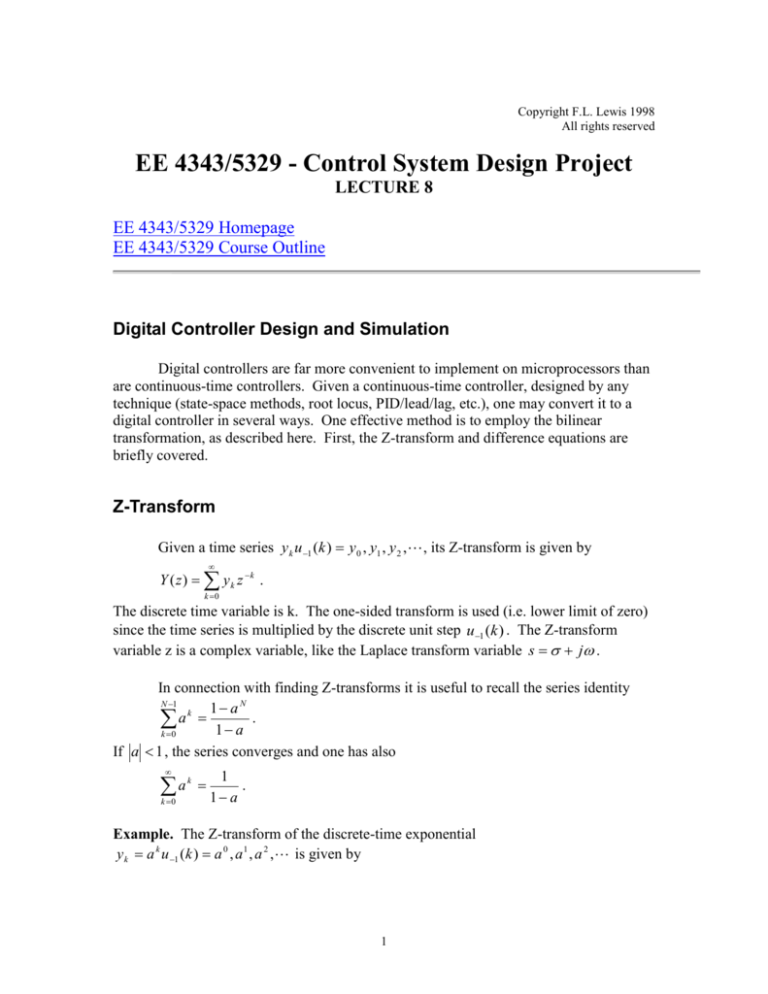
Copyright F.L. Lewis 1998
All rights reserved
EE 4343/5329 - Control System Design Project
LECTURE 8
EE 4343/5329 Homepage
EE 4343/5329 Course Outline
Digital Controller Design and Simulation
Digital controllers are far more convenient to implement on microprocessors than
are continuous-time controllers. Given a continuous-time controller, designed by any
technique (state-space methods, root locus, PID/lead/lag, etc.), one may convert it to a
digital controller in several ways. One effective method is to employ the bilinear
transformation, as described here. First, the Z-transform and difference equations are
briefly covered.
Z-Transform
Given a time series y k u 1 (k ) y 0 , y1 , y 2 , , its Z-transform is given by
Y ( z ) y k z k .
k 0
The discrete time variable is k. The one-sided transform is used (i.e. lower limit of zero)
since the time series is multiplied by the discrete unit step u 1 (k ) . The Z-transform
variable z is a complex variable, like the Laplace transform variable s j .
In connection with finding Z-transforms it is useful to recall the series identity
N 1
1 aN
k
.
a
1 a
k 0
If a 1 , the series converges and one has also
a
k 0
k
1
.
1 a
Example. The Z-transform of the discrete-time exponential
y k a k u 1 (k ) a 0 , a 1 , a 2 , is given by
1
1
z
.
1
za
1 az
k 0
k 0
This has a pole at z=a and a zero at z=0.
Y ( z ) a k z k (az 1 ) k
Example. The discrete unit step u 1 (k ) 1,1,1, (i.e. a sequence of 1's which begins at
time k=0) is a special case of the discrete exponential having a=1. Its Z-transform is
1
z
Y ( z)
,
1
z 1
1 z
which has a pole at z=1 and a zero at z=0.
Example. The discrete unit pulse u0 (k ) 1,0,0, (i.e. a one occurring at time k=0) has
transform
Y ( z ) u 0 (k ) 1,
k 0
i.e. a constant surface which has no poles or zeros.
Note that Z-transforms of causal signals beginning at k=0 generally have a z in
the numerator. This is due to the fact that what appears in the summation is z-1.
Sampling of Continuous-Time Signals
The continuous-time exponential is y (t ) et u t (t ) , where for stability the real
part of the pole is negative. Selecting a SAMPLING PERIOD T, one relates the
continuous and discrete time variables by
t kT .
Then, the continuous exponential becomes
et e akT (eT ) k a k
with a e T . This provides a mapping between continuous poles and discrete poles of
time functions.
For instance, if the continuous-time pole is at s= = -2 and the sampling period is
T= 10msec= 0.01 sec, then one has the discrete pole at z e 2(.01) e .02 0.98 . Note
that a continuous pole at s= 0 maps to a discrete pole at z e 0 1 .
Given this mapping, it is now instructive to compare the examples above with
their continuous-time counterparts. In fact, note that the continuous unit step, which has
the Laplace transform of 1/s, has a pole at s=0, while the discrete unit step has a pole at
z=1. The continuous exponential et has a pole at s=, while the discrete exponential
has a pole at z eT , with T the sampling period. The discrete unit pulse and the
(continuous) unit impulse both have constant transforms of 1.
2
Inverse Z-Transform
The inverse Z-transform may be found in several ways.
Example. Inverse Z-Transform by Long Division
z
. One can determine the associated time series yk
z 1.7 z 0.72
by writing this in the form
Suppose Y ( z )
2
Y ( z ) y k z k y 0 y1 z 1 y 2 z 2
k 0
by any technique. One way to do this is by long division. In fact, one may write
z 1.7 z 0.72
2
z 1 1.7 z 2
.
z
z 1.7 0.72 z 1
1.7 0.72 z 1
1.7 2.89 z 1 1.224 z 2
The inverse Z-transform appears in the quotient, so that yk= 0, 1, 1.7, …
Example. Inverse Z-Transform by Partial Fraction Expansion
Exactly as for the Laplace transform inverse, one may use the PFE. Thus, write
z
1
10
10 z
10 z
10
Y ( z) 2
z
z
.
z 0.9 z 0.8
z 1.7 z 0.72 ( z 0.9)( z 0.8)
z 0.9 z 0.8
The residues are determined exactly as in the continuous-time case. Note, however, that
one keeps the factor z out of the PFE to obtain the z in the numerators of the expansion.
This is necessary since Z-transforms generally have a zero at z=0.
Now, according to the examples worked above, the time series is given as
y k 10(0.9 k 0.8 k )u 1 (k ) .
Evaluating the first few terms gives yk= 0, 1, 1.7, … This is the same result obtained by
long division.
The PFE is generally preferable to long division since it yields closed-form
solutions.
Difference Equations
To simulate the continuous-time state equation x f ( x, u ) one must use a
numerical integrator such as Runge-Kutta. This means that to implement a controller
3
described in terms of differential equations, one needs a numerical integrator, which is
inconvenient. This applies to any controller K(s) described in terms of Laplace
transforms. The simulation of DIFERENCE EQUATIONS is far easier than the
simulation of differential equations. This means that controllers described in terms of
difference equations are very easy to implement on a digital microprocessor. This applies
to controllers K(z) described in terms of Z-transforms. Before showing how to design
digital controllers, we briefly discuss difference equations, and relate them to Ztransforms.
A linear time-invariant system may be described in discrete time in terms of its
DISCRETE TRANSFER FUNCTION H(z). Then the input U(z) and output Y(z) are
related by
Y ( z ) H ( z )U ( z ) .
Writing more detail in terms of the numerator and denominator polynomials, one has
b0 z m b1 z m1 bm1 z bm
Y ( z ) H ( z )U ( z ) n
U ( z)
z a1 z n 1 a n 1 z a n
where the denominator degree is n , the numerator degree is m n , and the relative
degree is n-m.
Dividing through by zn one may write
1
bm1 z ( m1) bm z m
d b0 b1 z
Y ( z ) H ( z )U ( z ) z
U ( z)
1 a1 z 1 a n 1 z ( n 1) a n z n
where the SYSTEM DELAY is d= n-m. Now one writes
(1 a1 z 1 a n z n )Y ( z ) z d (b0 b1 z 1 bm z m )U ( z ) .
We will abuse notation now and define an operator z-1 in the time domain. To see
what z yk means, write its transform as
-1
k 0
k 0
Y ' ( z ) ( z 1 y k ) z k y k z ( k 1)
Now change variables to K=k+1 to see that
Y ' ( z ) y K 1 z K .
K 1
That is, z-1yk is a delayed version yk-1 of the time series.
The Z-transform SHIFT PROPERTY says that multiplying the Z-transform by z-1
delays the time series by one. Compare this to the Laplace transform property which says
that multiplying the transform by 1/s amounts to integrating the time function.
In continuous-time systems, the memory resides in the integrators 1/s. In
discrete-time systems, the memory resides in the delays z-1. A series of delays is nothing
but a shift register.
Now one may write the input/output relation of the digital system as
4
y k a1 y k 1 an y k n b0 u k d b1u k d 1 bm u k d m
or
y k a1 y k 1 an y k n b0 u k d b1u k d 1 bm u k d m .
This is a difference equation describing the digital system.
Example. Let the digital transfer function be
z
1
H ( z) 2
z 1
.
1
z 1.7 z 0.72
1 1.7 z 0.72 z 2
Then one has Y(z)=H(z)U(z) or
(1 1.7 z 1 0.72 z 2 )Y ( z ) z 1U ( z )
so that in the time domain one has the difference equation
y k 1.7 y k 1 0.72 y k 2 u k 1 .
The system delay is d=1.
The meaning of the system delay is that a control uk applied at time k has no
influence on the output until time k+d. In the, last example, for instance, uk affects yk+1,
not yk.
Discretization of Continuous-Time Controllers
By any of a variety of techniques, one may design a continuous-time compensator
K(s). This may be converted to digital form K(z) using several techniques, among the
most direct of which is the bilinear transformation (BLT).
The relation between the Laplace transform variable s and the Z-transform
variable z is z=esT, with T the sampling period. However, using this to transform K(s) to
K(z) will give non-polynomial transfer functions. Note that
1 sT
sT
2
e
sT
1
2
Therefore define the BLT by
1 sT
2,
z
sT
1
2
and its inverse
2 z 1
s
.
T z 1
To convert a continuous transfer function K(s) to a discrete transfer function using
2 z 1
sample period T, then, one simply replaces all occurrences of s by
. That is
T z 1
5
K ( z ) K (s) s 2 z 1 .
T z 1
Conversion of LPF to Digital Form
A continuous-time low pass filter is given by
K (s)
.
s
This could be a compensation network designed using, e.g. root locus techniques. To
convert this to a digital controller one writes
z 1
,
K ( z)
za
2 z 1
T z 1
1 T
2 . Note that the continuous filter has a pole
where the digital filter pole is at a
T
1
2
at s= -.
Note that here the BLT yields a zero at z=-1. This is because there is one zero at
infinity in K(s). The BLT maps finite poles and zeros according to
1 sT
2.
z
sT
1
2
Digital PID Controller
The continuous-time PID controller can be written in the form
Td s
1
K ( s ) k 1
Ti s 1 Td s
where Ti is the integration time constant or 'reset time', Td is the derivative time constant,
and is a large filtering pole (usually set to about 10 by the manufacturer).
Unfortunately, to implement this PID controller, one would require some sort of
numerical integration routine such as Runge-Kutta.
To convert this to digital form using the BLT, write
2 z 1
Td
1
T z 1
K ( z) k 1
.
Td 2 z 1
2 z 1
Ti T z 1 1 T z 1
This may be simplified to obtain
6
T z 1 TdD z 1
K ( z ) k 1
,
TiD z 1 T z D
where the digital integral and derivative time constants are
TiD 2Ti
TdD
T
1 T
2Td
and the discrete filtering pole is given by
1 T
2Td
.
D
T
1
2Td
It is easy to implement this digital PID controller using difference equations. In
fact, if the control input is given by u k K ( z )ek , with ek the tracking error, then divide
through by the highest power of z to obtain
T 1 z 1 TdD 1 z 1
u k K ( z 1 )ek k 1
ek .
1
T 1 D z 1
TiD 1 z
Now implement the I term separately as
T 1 z 1
u ki
ek
TiD 1 z 1
which yields
T
u ki u ki 1
(ek ek 1 ) .
TiD
Implement the D term as
T
1 z 1
u kd dD
ek
T 1 D z 1
or
T
u kd D u kd1 dD (ek ek 1 ) .
T
The complete control input is then given by the equation set
T
u ki u ki 1
(ek ek 1 ) .
TiD
T
u kd D u kd1 dD (ek ek 1 )
T
i
u k k (ek u k u kd ) .
This is the digital controller. No Runge-Kutta routine is needed to implement it, only
difference equations, which are easily programmed on a computer.
7
Note that the integral input is computed by adding to its previous value the
average of two consecutive error terms. The derivative term is computed from the
difference between two consecutive error terms.
8



